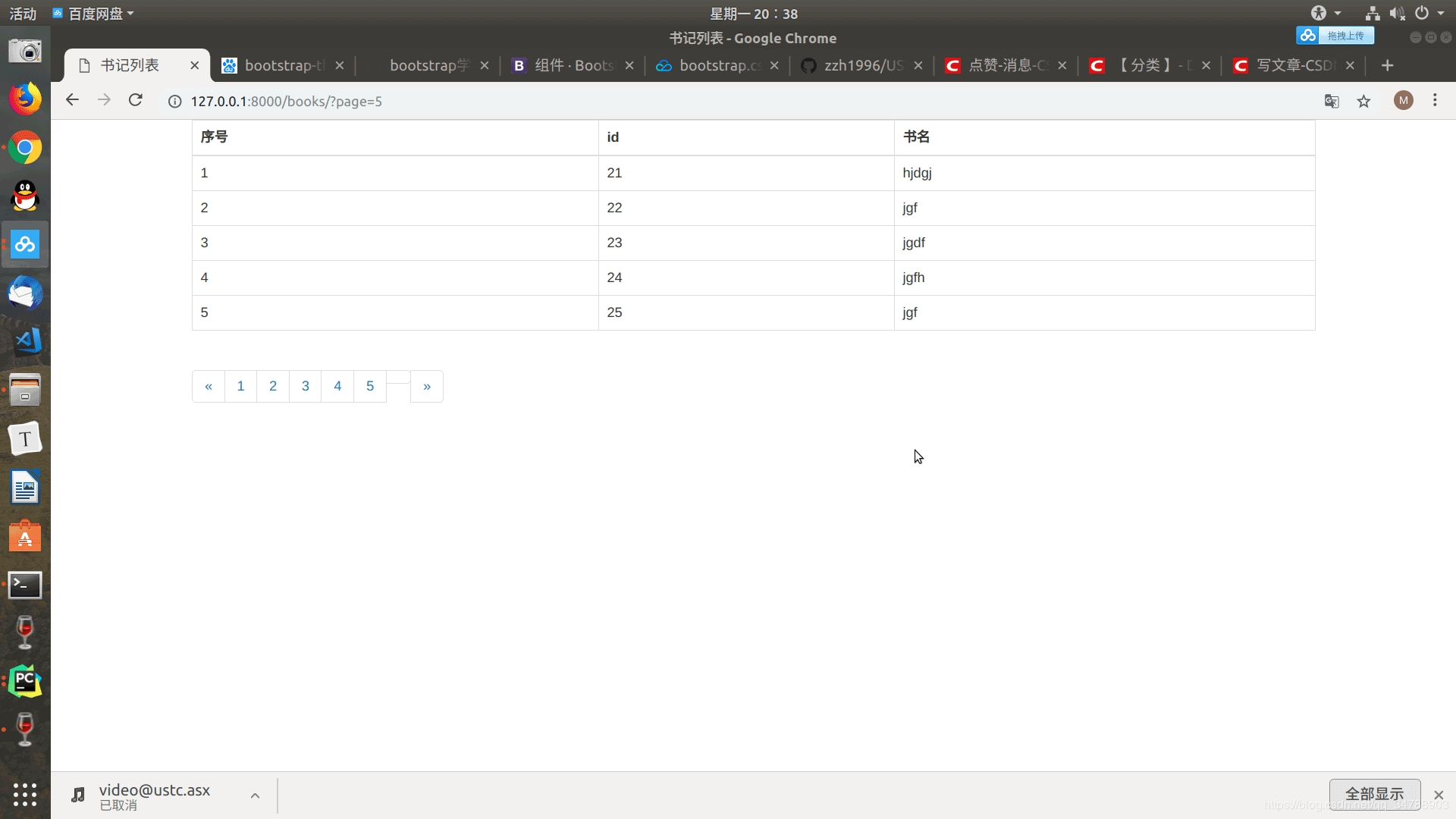Django框架实现的分页demo示例
Posted tacatno
tags:
篇首语:本文由小常识网(cha138.com)小编为大家整理,主要介绍了Django框架实现的分页demo示例相关的知识,希望对你有一定的参考价值。
首先初始化model,建表
|
1
2
3
4
5
6
|
class Book(models.Model): name = models.CharField(max_length=20) def __str__(self): return self.name class Meta: db_table = ‘books‘ |
然后用pycharm的数据库模块可视化插入
分页思路
url传递参数http://127.0.0.1:8000/books/?page=5比如这样传递的参数就是5,就显示第五页,
1.get到所有图书对象
2.计算好每一页应该有几个数据
3.根据不同的page值传递
|
1
2
3
4
5
6
7
8
9
10
11
12
13
14
15
16
17
18
19
20
|
def books(request): #取从url传递的参数 page_num = request.GET.get(‘page‘) page_num = int(page_num) start = (page_num-1)*5 end = page_num*5 #总页码数是? per_page = 5 total = models.Book.objects.all().count() total,more =divmod(total,per_page) if more: total+=1 all_books = models.Book.objects.all()[start:end] #自己拼接分页的html代码 html_str_list = [] for i in range(1,total): tmp = ‘<li><a href="/books/?page={}" rel="external nofollow" rel="external nofollow" rel="external nofollow" rel="external nofollow" >{}</li>‘.format(i,i) html_str_list.append(tmp) page_html = "".join(html_str_list) return render(request,‘books.html‘,{‘books‘:all_books,‘total_page‘:total,‘page_html‘:page_html}) |
拿到数据总量的值,每一页的数量为5,如果有余数则total+1也就是增加一个页面.
建立一个列表,去拼接a标签,最后传递给前端
前端
前端的样式用到了boottrap,可以直接看文档.
|
1
2
3
4
5
6
7
8
9
10
11
12
13
14
15
16
17
18
19
20
21
22
23
24
25
26
27
28
29
30
31
32
33
34
35
36
37
38
39
40
41
42
43
44
45
|
<!DOCTYPE html><html lang="en"><head> <meta charset="UTF-8"> <title>书记列表</title> <link rel="stylesheet" href="/static/bootstrap/css/bootstrap.css" rel="external nofollow" ></head><body><div class="container"> <table class="table table-bordered"> <thead> <tr> <th>序号</th> <th>id</th> <th>书名</th> </tr> </thead> <tbody> {% for book in books %} <tr> <td>{{ forloop.counter }}</td> <td>{{ book.id }}</td> <td>{{ book.name }}</td> </tr> {% endfor %} </tbody> </table><nav aria-label="Page navigation"> <ul class="pagination"> <li> <a href="#" rel="external nofollow" rel="external nofollow" aria-label="Previous"> <span aria-hidden="true">«</span> </a> </li> {{ page_html|safe }} <li> <a href="#" rel="external nofollow" rel="external nofollow" aria-label="Next"> <span aria-hidden="true">»</span> </a> </li> </ul></nav></div></body></html> |
|
1
|
{{ page_html|safe }} |
传递过来的page_html要用safe过滤器,不然无法转移成html.
最终效果
分页优化
设置一个首页一个尾页,以及显示局部的页面
|
1
2
3
4
5
6
7
8
9
10
11
12
13
14
15
16
17
18
19
20
21
22
23
24
25
26
27
28
29
30
31
32
33
34
|
def books(request): # 取从url传递的参数 page_num = request.GET.get(‘page‘) page_num = int(page_num) start = (page_num - 1) * 5 end = page_num * 5 # 总页码数是? per_page = 5 # 页面上总共展示多少页面 max_page = 11 half_max_page = max_page // 2 # 页面上展示的页面从哪开始 page_start = page_num - half_max_page if page_start <= 1: page_start = 1 total = models.Book.objects.all().count() # 页面到哪结束 page_end = page_num+half_max_page if page_end > total: page_end = total page_start = total - max_page total, more = divmod(total, per_page) if more: total += 1 all_books = models.Book.objects.all()[start:end] # 自己拼接分页的html代码 html_str_list = [] html_str_list.append(‘<li><a href="/books/?page={}" rel="external nofollow" rel="external nofollow" rel="external nofollow" rel="external nofollow" >首页</li>‘.format(1,1)) for i in range(page_start, page_end+1): tmp = ‘<li><a href="/books/?page={}" rel="external nofollow" rel="external nofollow" rel="external nofollow" rel="external nofollow" >{}</li>‘.format(i, i) html_str_list.append(tmp) html_str_list.append(‘<li><a href="/books/?page={}" rel="external nofollow" rel="external nofollow" rel="external nofollow" rel="external nofollow" >最后一页</li>‘.format(total)) page_html = "".join(html_str_list) return render(request, ‘books.html‘, {‘books‘: all_books, ‘total_page‘: total, ‘page_html‘: page_html}) |
以上是关于Django框架实现的分页demo示例的主要内容,如果未能解决你的问题,请参考以下文章
